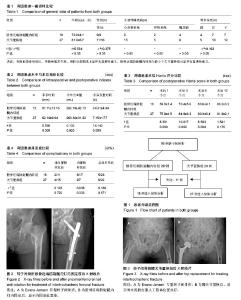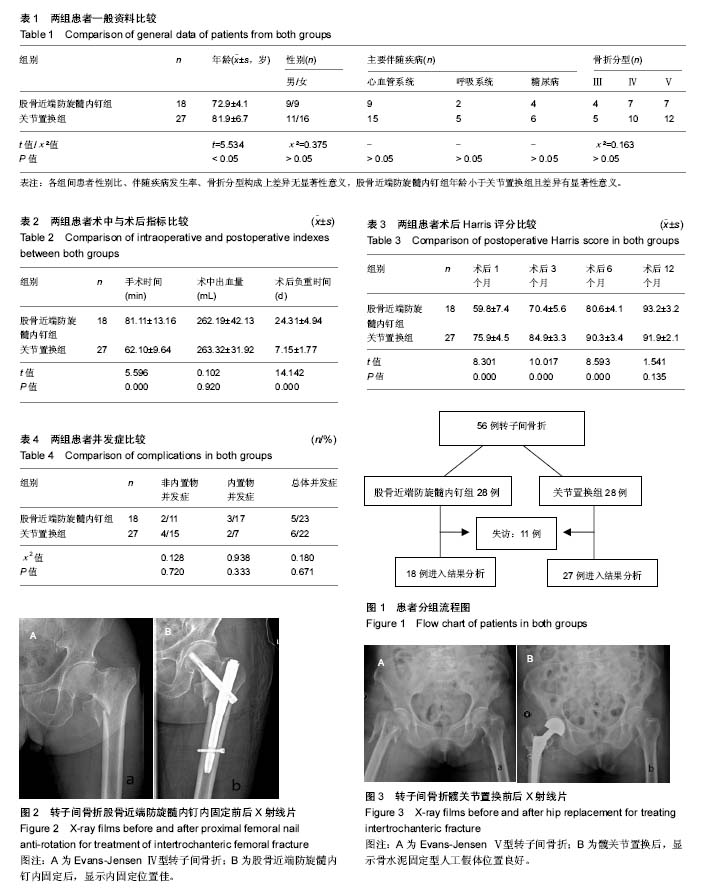| [1] 张英泽. 成人髋部骨折指南解读[J]. 中华外科杂志, 2015,53(1): 57-62.[2] Yoon BH,Baek JH, Kim MK,et al.Poor prognosis in elderly patients who refused surgery because of economic burden and medical problem after hip fracture.J Korean Med Sci. 2013;28(9):1378-1381.[3] Li K,Zheng Y.Internal fixation versus conservative treatment for elderly patients with a trochanteric hip fracture in conjunction with post-stroke hemiplegia.Injury. 2016;47(10): 2169-2172.[4] Daugaard CL,Jorgensen HL,Riis T,et al.Is mortality after hip fracture associated with surgical delay or admission during weekends and public holidays? A retrospective study of 38,020 patients. Acta Orthop.2012;83(6):609-613.[5] 姜源涛,焦建宝,薛金伟,等.骨股头双极假体置换及内固定修复老年股骨颈骨折的生物力学特征[J].中国组织工程研究, 2016, 20(26):2095-4344.[6] 叶向阳,王华磊,赵玉果,等.一期全髋置换与股骨头置换修复老年股骨颈骨折:髋关节功能与并发症的Meta分析[J].中国组织工程研究, 2016,20(22):3328-3336.[7] 陈永龙,张怡五,王晓勇,等.DHS治疗老年股骨转子间骨折失败原因剖析及预防探讨[J].重庆医学, 2009,38(8):964-965.[8] 林伟鹏,叶劲,邹仲兵,等.闭合复位内固定治疗老年股骨转子间骨折术后内固定失败的影响因素分析[J].中华创伤骨科杂志,2016, 18(7):625-629.[9] Hu YG,Han L,Fang WL,et al.Comparison of anatomical locking plate and Gamma nail for the treatment of intertrochanteric fracture with external wall fractures. Zhongguo Gu Shang. 2016;29(6):496-501.[10] 孟凯,谢进,杨明吾.DCS内固定治疗老年性股骨逆转子间骨折[J].中医正骨, 2007,19(12):20, 22.[11] Yu W,Zhang X,Zhu X,et al.Proximal femoral nails anti-rotation versus dynamic hip screws for treatment of stable intertrochanteric femur fractures: an outcome analyses with a minimum 4 years of follow-up. BMC Musculoskelet Disord. 2016;17:222.[12] Shen L,Zhang Y,Shen Y,et al.Antirotation proximal femoral nail versus dynamic hip screw for intertrochanteric fractures: a meta-analysis of randomized controlled studies.Orthop Traumatol Surg Res.2013;99(4):377-383.[13] 童培建.正确认识关节置换治疗股骨转子间骨折[J].中华创伤杂志, 2015,31(1):3-6.[14] 刘景一,闫军,豆青军,等.骨水泥型人工髋关节置换治疗首次治疗失败的高龄股骨转子间骨折[J]. 中华创伤骨科杂志, 2015,17(5): 455-457.[15] 郭宁峰,庞清江,邱惠斌,等.人工关节置换术治疗高龄股骨转子间粉碎性骨折[J].临床骨科杂志, 2011,14(4):384-386.[16] 邵明,毕郑刚,贺胜,等.人工关节置换与髓内钉固定治疗高龄严重骨质疏松股骨转子间骨折的疗效比较[J]. 中华创伤骨科杂志, 2013,15(5):402-406.[17] 张庆猛,李明,刘培来,等.人工关节置换和PFNA内固定治疗老年人股骨转子间骨折的疗效比较[J].山东医药, 2013,53(1):69-71.[18] Tang P,Hu F,Shen J,et al.Proximal femoral nail antirotation versus hemiartificial joint replacement: a study for the treatment of intertrochanteric fractures. Injury.2012;43(6): 876-881. [19] Li Y,Zhao WB,Wang DL,et al.Treatment of osteoporotic intertrochanteric fractures by zoledronic acid injection combined with proximal femoral nail anti-rotation.Chin J Traumatol.2016;19(5):259-263.[20] Yu W, Zhang X, Wu R, et al.The visible and hidden blood loss of Asia proximal femoral nail anti-rotation and dynamic hip screw in the treatment of intertrochanteric fractures of elderly high-risk patients: a retrospective comparative study with a minimum 3 years of follow-up.BMC Musculoskelet Disord. 2016;17:269.[21] Yu W, Zhang X, Zhu X,et al.A retrospective analysis of the InterTan nail and proximal femoral nail anti-rotation-Asia in the treatment of unstable intertrochanteric femur fractures in the elderly.J Orthop Surg Res.2016;11:10.[22] Ma KL, Wang X, Luan FJ,et al.Proximal femoral nails antirotation, Gamma nails, and dynamic hip screws for fixation of intertrochanteric fractures of femur: A meta-analysis.Orthop Traumatol Surg Res. 2014;100(8): 859-866. [23] Li YJ, Li ZB, Yu WH, et al.Case-control study on dynamic hip screw and proximal femoral nail anti-rotation for the treatment of unstable intertrochanteric fractures in elderly patients. Zhongguo Gu Shang.2013;26(12):977-980. [24] Guo Q, Shen Y, Zong Z,et al.Percutaneous compression plate versus proximal femoral nail anti-rotation in treating elderly patients with intertrochanteric fractures: a prospective randomized study.J Orthop Sci.2013;18(6):977-986.[25] Zeng C, Wang Y, Wei J,et al.Meta-analysis of proximal femoral nail anti-rotation versus dynamic hip screw in the treatment of trochanteric fractures.Zhong Nan Da Xue Xue Bao Yi Xue Ban. 2012;37(6):606-615. [26] Zhou F, Zhang ZS, Yang H,et al.Less invasive stabilization system (LISS) versus proximal femoral nail anti-rotation (PFNA) in treating proximal femoral fractures: a prospective randomized study.J Orthop Trauma. 2012 Mar;26(3):155-162.[27] Shi Y, Chen ZJ, Hong ZY,et al.Case-control study on retaining articular capsule in the total hip replacement for old patients with unstable femoral neck fractures.Zhongguo Gu Shang. 2016;29(11):989-993. [28] Lu XD,Wang B,Xu W,et al.Comparison of calcar replacement arthroplasty and Intertan nail in treatment of intertrochanteric fracture in the aged.Zhonghua Yi Xue Za Zhi.2016;96(31): 2466-2471.[29] Lim JW, Ng GS, Jenkins RC,et al.Total hip replacement for neck of femur fracture: Comparing outcomes with matched elective cohort.Injury. 2016;47(10):2144-2148.[30] Coomber R, Porteous M, Hubble MJW,et al.Total hip replacement for hip fracture: Surgical techniques and concepts. Injury. 2016;47(10):2060-2064.[31] 白东昱,薛亮,赵程锦.人工股骨头置换与股骨近端防旋髓内钉治疗老年转子间骨折107例[J].陕西医学杂志,2017,46(1):79-81.[32] 王玉忠,张新茶.加长柄人工双极股骨头置换治疗高龄不稳定型股骨转子间骨折的疗效[J].医学临床研究,2017,34(1):100-102.[33] 姜自伟,虎群盛,黄枫,等.周琦石PFNA-Ⅱ治疗不稳定型股骨转子间骨折的动态有限元研究[J].山东医药 2016,56(33):14-17,21. |

